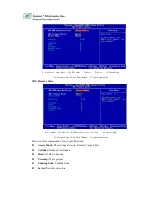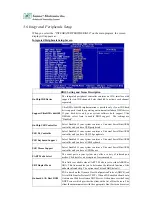
3.6 Integrated Peripherals Setup
When you select the “INTEGRATED PERIPHERIALS” on the main program, the screen
display will appears as:
Integrated Peripherals Setup Screen
BIOS Setting and Terms Description
OnChip IDE Device
The integrated peripheral controller contains an IDE interface with
support for two IDE channels. Select Enabled to activate each channel
separately.
Support UltraDMA 66&100
Ultra DMA/66&100 implementation is possible only if your IDE hard
drive supports it and the operating environment includes a DMA driver.
If your hard drive and your system software both support Ultra
DMA/66, select Auto to enable BIOS support. The settings are
“Disabled”.
OnChip USB Controller
Select Enabled if your system contains a Universal Serial Bus(USB)
controller and you have USB peripherals.
USB 2.0 Controller
Select Enabled if your system contains a Universal Serial Bus(USB)
controller and you have USB 2.0 peripherals.
USB Keyboard Support
Select Enabled if your system contains a Universal Serial Bus(USB)
controller and you have a USB keyboard.
USB Mouse Support
Select Enabled if your system contains a Universal Serial Bus(USB)
controller and you have a USB Mouse.
UART Mode Select
The serial port on your system may offer a variety of infrared port
modes. Click here for a description of various modes.
UR2 Duplex Mode
This field is available when UART 2 Mode is set to either ASKIR or
IrDA. This item enables you to determine the infrared function of the
onboard infrared chip. The options are Full and Half (default).
Onboard LAN Boot ROM
PXE is based on the Dynamic Host Configuration Protocol (DHCP), and
Trivial File Transfer Protocol (TFTP). When a PXE enabled client boots,
it obtains an IP address from a DHCP server. It then discovers the Proxy
DHCP server, which provides the client with a list of Boot Servers. The
client then communicates with the appropriate Boot Server and receives

































